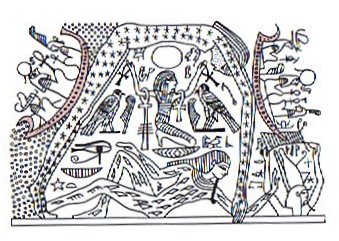4. Also Ga1-1 can be said to illustrate how 2 in reality is only 1:
Also Ga1-1 is drawn to make the viewer conclude the recurrence of a single element. The single element in Gb8-30 is of the type at top right in Gb6-18 (notably a Saturday):
In Ga1-1 the single element is basically of the type which I have named haga rave:
I will here take the opportunity to illustrate why its name became haga rave and not haga which would have been more convenient. The statistics regarding the glyph type, which I once had provisionally named GD36, show that Metoro often said simply haga rather than haga rave at GD36:
But already from considering the 32 cases of GD36 in the text of B (Aruku Kurenga) it became obvious that haga would not be a good label, because although Metoro said haga at 13 of these 32 glyphs (40 % of them), he used this word also at 50 other types of glyphs:
By adding the qualification rave only the following GD36 glyphs remained (and no glyphs of other types):
A quick look at the 50 haga non-GD36 glyphs in B reveals the presence of no less than 7 mea ke signs, which seems significant because there are no more than 14 mea ke glyphs in B. Judging solely from the B text it would have been tempting to label them haga glyphs rather than mea ke glyphs:
The example shows how relatively arbitrary some of my glyph type names can be, in spite of all my efforts to find the best fit between the words of Metoro and the signs in the texts he read. It also suggests a rather close connection in meaning between haga rave and mea ke, and therefore indirectly also between haga rave and puo:
Thus the words of Metoro can be used to find out connnections between the various glyph types. But we do not need the words of Metoro to see the puo and haga rave signs in Ba8-19--20:
In the cycle of time haga rave comes after puo (in Ba8-19 formed by the abdomen and head of the strange creature). Ba8-19--20 helps us to understand 'omega' and 'alpha' in the G text:
A profound difference can be detected, though, because there is a single head in Ba8-19 and a single open mouth in Ba8-20, whereas in G puo and haga rave apparently are connected with number 2:
Ba8-19 is a Sun-day, but Gb8-30 is at the other end of time, it is a day of Jupiter. The left arm in Ba8-20 corresponds in position to the left 'arm' in Ga1-1 and the open mouth corresponds to the 'open mouth' in Ga1-1. But there is no right arm in Ga1-1. Thus Ga1-1 possibly has a sign of 'only 1 limb'. It could mean that Spring Sun (the probable subject of the front side of the tablet), disappears when we reach midsummer. Then comes a season of clouds and rain. Haga rave is similar in shape to an open (eating) mouth, and in spring food once again is available after the harsh winter season. Everything in nature grows and flourishes thanks to the returning Spring Sun.
Rave can mean 'to receive' ('take'). But another interpreation is conveyed by the picture of haga rave, viz. a fish hook (caught in the stones):
Maybe the idea is to allude to how Maui (and other 'heroes') fished up 'land' from the 'sea': ... The brothers of Maui sat trembling in the middle of the canoe, fearing for their lives. For now the water was frothing and heaving, and great hot bubbles were coming up, and steam, and Maui was chanting the incantation called Hiki, which makes heavy weights light. At length there appeared beside them the gable and thatched roof of the house of Tonganui, and not only the house, but a huge piece of the land attached to it. The brothers wailed, and beat their heads, as they saw that Maui had fished up land, Te Ika a Maui, the fish of Maui. And there were houses on it, and fires burning, and people going about their daily tasks. Then Maui hitched his line round one of the paddles laid under a pair of thwarts, and picked up his maro, and put it on again ... Land here probably refers to the season of spring, when 'ebb' once again reveals the source of food, when the waters ('black cloth') of winter subsides, when time turns back to the front side of the year, i.e. winter solstice. Tonganui means the Great South and Maui hitched his line around only one of his paddels when he put on his maro again (after a time when he had been naked like a newborn child). It is the time when Spring Sun is reborn, when land once again will see broad daylight:
At left in the Egyptian picture the 'bubbles of water' means the night side, the back side. At right the ship of Pharaoh has stranded on 'the elbow of the sky' (spring equinox), and dawn (summer) has come. '... For now the water was frothing and heaving, and great hot bubbles were coming up, and steam, and Maui was chanting the incantation called Hiki, which makes heavy weights light.' Bubbles of steam will rise in spite of the force of gravity. What is hot (like the flames of a fire) goes up and what is cool (like water) goes down. In spring the sky is moving upwards, beyond midsummer the sky is moving downwards. |





































